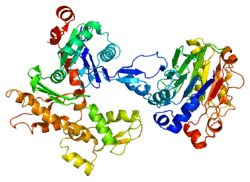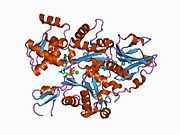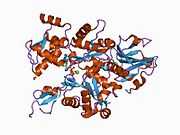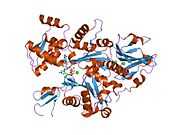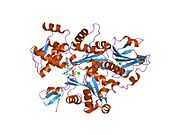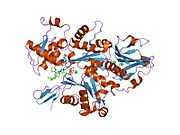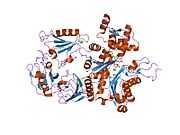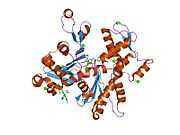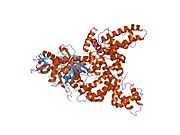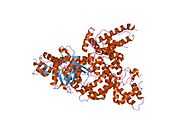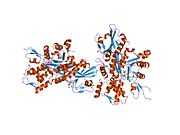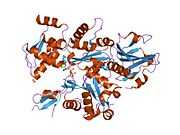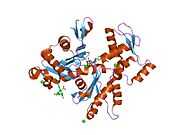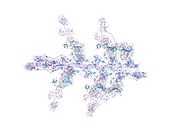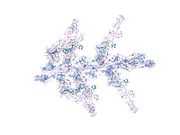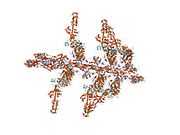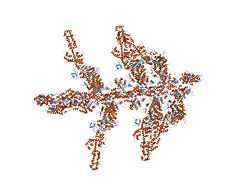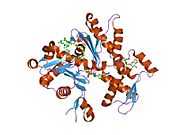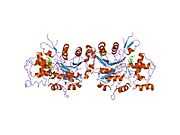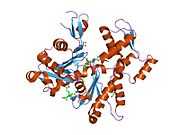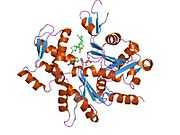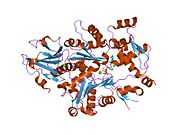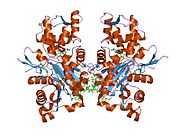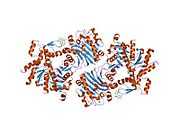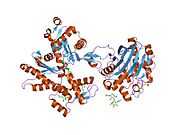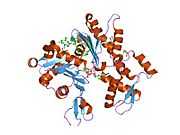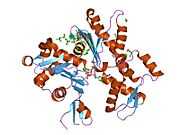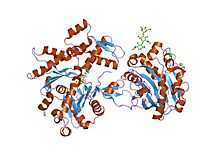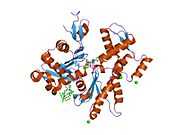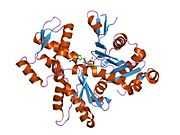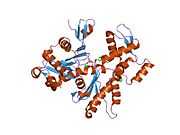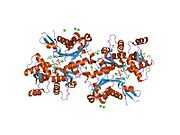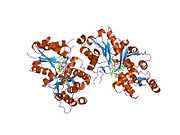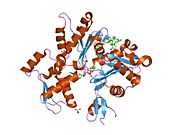ACTC1
ACTC1 encodes cardiac muscle alpha actin.[1][2] This isoform differs from the alpha actin that is expressed in skeletal muscle, ACTA1. Alpha cardiac actin is the major protein of the thin filament in cardiac sarcomeres, which are responsible for muscle contraction and generation of force to support the pump function of the heart.
Structure
Cardiac alpha actin is a 42.0 kDa protein composed of 377 amino acids.[3][4] Cardiac alpha actin is a filamentous protein extending from a complex mesh with cardiac alpha-actinin (ACTN2) at Z-lines towards the center of the sarcomere. Polymerization of globular actin (G-actin) leads to a structural filament (F-actin) in the form of a two-stranded helix. Each actin can bind to four others. The atomic structure of monomeric actin was solved by Kabsch et al.,[5] and closely thereafter this same group published the structure of the actin filament.[6] Actins are highly conserved proteins; the alpha actins are found in muscle tissues and are a major constituent of the contractile apparatus. Cardiac (ACTC1) and skeletal (ACTA1) alpha actins differ by only four amino acids (Asp4Glu, Glu5Asp, Leu301Met, Ser360Thr; cardiac/skeletal). The actin monomer has two asymmetric domains; the larger inner domain comprised by sub-domains 3 and 4, and the smaller outer domain by sub-domains 1 and 2. Both the amino and carboxy-termini lie in sub-domain 1 of the outer domain.
Function
Actin is a dynamic structure that can adapt two states of flexibility, with the greatest difference between the states occurring as a result of movement within sub-domain 2.[7] Myosin binding increases the flexibility of actin,[8] and cross-linking studies have shown that myosin subfragment-1 binds to actin amino acid residues 48-67 within actin sub-domain 2, which may account for this effect.[9]
It has been suggested that the ACTC1 gene has a role during development. Experiments in chick embryos found an association between ACTC1 knockdown and a reduction in the artrial septa.[10]
Clinical Significance
Polymorphisms in ACTC1 have been linked to Dilated Cardiomyopathy in a small number of Japanese patients.[11] Further studies in patients from South Africa found no association.[12] The E101K missense mutation has been associated with Hypertrophic Cardiomyopathy[13][14][15][16] and Left Ventricular Noncompaction.[17] Another mutation has in the ACTC1 gene has been associated with atrial septal defects.[10]
References
- ↑ Kramer PL, Luty JA, Litt M (Aug 1992). "Regional localization of the gene for cardiac muscle actin (ACTC) on chromosome 15q". Genomics 13 (3): 904–5. doi:10.1016/0888-7543(92)90185-U. PMID 1639426.
- ↑ "Entrez Gene: ACTC1 actin, alpha, cardiac muscle 1".
- ↑ "Protein Information – Basic Information: Protein COPaKB ID: P68032". Cardiac Organellar Protein Atlas Knowledgebase.
- ↑ Zong, N. C.; Li, H; Li, H; Lam, M. P.; Jimenez, R. C.; Kim, C. S.; Deng, N; Kim, A. K.; Choi, J. H.; Zelaya, I; Liem, D; Meyer, D; Odeberg, J; Fang, C; Lu, H. J.; Xu, T; Weiss, J; Duan, H; Uhlen, M; Yates Jr, 3rd; Apweiler, R; Ge, J; Hermjakob, H; Ping, P (2013). "Integration of cardiac proteome biology and medicine by a specialized knowledgebase". Circulation Research 113 (9): 1043–53. doi:10.1161/CIRCRESAHA.113.301151. PMC 4076475. PMID 23965338.
- ↑ Kabsch, W; Mannherz, H. G.; Suck, D; Pai, E. F.; Holmes, K. C. (1990). "Atomic structure of the actin:DNase I complex". Nature 347 (6288): 37–44. doi:10.1038/347037a0. PMID 2395459.
- ↑ Holmes, K. C.; Popp, D; Gebhard, W; Kabsch, W (1990). "Atomic model of the actin filament". Nature 347 (6288): 44–9. doi:10.1038/347044a0. PMID 2395461.
- ↑ Egelman, E. H.; Orlova, A (1995). "New insights into actin filament dynamics". Current opinion in structural biology 5 (2): 172–80. PMID 7648318.
- ↑ Orlova, A; Egelman, E. H. (1993). "A conformational change in the actin subunit can change the flexibility of the actin filament". Journal of Molecular Biology 232 (2): 334–41. doi:10.1006/jmbi.1993.1393. PMID 8345515.
- ↑ Bertrand, R; Derancourt, J; Kassab, R (1994). "The covalent maleimidobenzoyl-actin-myosin head complex. Cross-linking of the 50 k Da heavy chain region to actin subdomain-2". FEBS letters 345 (2-3): 113–9. PMID 8200441.
- ↑ 10.0 10.1 Matsson H et al. (Jan 2008). "Alpha-cardiac actin mutations produce atrial septal defects.". Hum Mol Genet. 17 (2): 256–65. doi:10.1093/hmg/ddm302. PMID 17947298.
- ↑ Takai E et al. (Oct 1999). "Mutational analysis of the cardiac actin gene in familial and sporadic dilated cardiomyopathy.". Am J Med Genet. 86 (4): 325–7. doi:10.1002/(SICI)1096-8628.
- ↑ Mayosi BM et al. (Oct 1999). "Cardiac and skeletal actin gene mutations are not a common cause of dilated cardiomyopathy.". J Med Genet. 36 (10): 796–7. doi:10.1136/jmg.36.10.796.
- ↑ Olson TM et al. (Sep 2000). "Inherited and de novo mutations in the cardiac actin gene cause hypertrophic cardiomyopathy.". J Mol Cell Cardiol. 32 (9): 1687–94. doi:10.1006/jmcc.2000.1204. PMID 10966831.
- ↑ Arad M et al. (Nov 2005). "Gene mutations in apical hypertrophic cardiomyopathy.". Circulation. 112 (18): 2805–11. doi:10.1161/CIRCULATIONAHA.105.547448.
- ↑ Monserrat L et al. (Aug 2007). "Mutation in the alpha-cardiac actin gene associated with apical hypertrophic cardiomyopathy, left ventricular non-compaction, and septal defects.". Eur Heart J. 28 (16): 1953–61. doi:10.1093/eurheartj/ehm239.
- ↑ Morita H et al. (May 2008). "Shared genetic causes of cardiac hypertrophy in children and adults.". N Engl J Med. 358 (18): 1899–908. doi:10.1056/NEJMoa075463.
- ↑ Klaassen S et al. (June 2008). "Mutations in sarcomere protein genes in left ventricular noncompaction.". Circulation. 117 (22): 2893–901. doi:10.1161/CIRCULATIONAHA.107.746164. PMID 1850600.
Further reading
- Snásel J, Pichová I (1997). "The cleavage of host cell proteins by HIV-1 protease.". Folia Biol. (Praha) 42 (5): 227–30. doi:10.1007/BF02818986. PMID 8997639.
- Bearer EL, Prakash JM, Li Z (2002). "Actin dynamics in platelets". Int. Rev. Cytol. International Review of Cytology 217: 137–82. doi:10.1016/S0074-7696(02)17014-8. ISBN 978-0-12-364621-7. PMC 3376087. PMID 12019562.
- Elzinga M, Maron BJ, Adelstein RS (1976). "Human heart and platelet actins are products of different genes". Science 191 (4222): 94–5. doi:10.1126/science.1246600. PMID 1246600.
- Adams LD, Tomasselli AG, Robbins P et al. (1992). "HIV-1 protease cleaves actin during acute infection of human T-lymphocytes". AIDS Res. Hum. Retroviruses 8 (2): 291–5. doi:10.1089/aid.1992.8.291. PMID 1540415.
- Dawson SJ, White LA (1992). "Treatment of Haemophilus aphrophilus endocarditis with ciprofloxacin". J. Infect. 24 (3): 317–20. doi:10.1016/S0163-4453(05)80037-4. PMID 1602151.
- Watkins C, Bodfish P, Warne D et al. (1992). "Dinucleotide repeat polymorphism in the human alpha-cardiac actin gene, intron IV (ACTC), detected using the polymerase chain reaction". Nucleic Acids Res. 19 (24): 6980. doi:10.1093/nar/19.24.6980-a. PMC 329379. PMID 1762945.
- Tomasselli AG, Hui JO, Adams L et al. (1991). "Actin, troponin C, Alzheimer amyloid precursor protein and pro-interleukin 1 beta as substrates of the protease from human immunodeficiency virus". J. Biol. Chem. 266 (22): 14548–53. PMID 1907279.
- Shoeman RL, Kesselmier C, Mothes E et al. (1991). "Non-viral cellular substrates for human immunodeficiency virus type 1 protease". FEBS Lett. 278 (2): 199–203. doi:10.1016/0014-5793(91)80116-K. PMID 1991513.
- Buckingham M, Alonso S, Barton P et al. (1987). "Actin and myosin multigene families: their expression during the formation and maturation of striated muscle". Am. J. Med. Genet. 25 (4): 623–34. doi:10.1002/ajmg.1320250405. PMID 3789022.
- Engel JN, Gunning PW, Kedes L (1982). "Isolation and characterization of human actin genes". Proceedings of the National Academy of Sciences of the United States of America 78 (8): 4674–8. doi:10.1073/pnas.78.8.4674. PMC 320222. PMID 6272269.
- Humphries SE, Whittall R, Minty A et al. (1982). "There are approximately 20 actin gene in the human genome". Nucleic Acids Res. 9 (19): 4895–908. doi:10.1093/nar/9.19.4895. PMC 327487. PMID 6273789.
- Hamada H, Petrino MG, Kakunaga T (1983). "Molecular structure and evolutionary origin of human cardiac muscle actin gene". Proceedings of the National Academy of Sciences of the United States of America 79 (19): 5901–5. doi:10.1073/pnas.79.19.5901. PMC 347018. PMID 6310553.
- Gunning P, Ponte P, Kedes L et al. (1984). "Chromosomal location of the co-expressed human skeletal and cardiac actin genes". Proceedings of the National Academy of Sciences of the United States of America 81 (6): 1813–7. doi:10.1073/pnas.81.6.1813. PMC 345011. PMID 6584914.
- Gunning P, Ponte P, Blau H, Kedes L (1984). "alpha-skeletal and alpha-cardiac actin genes are coexpressed in adult human skeletal muscle and heart". Mol. Cell. Biol. 3 (11): 1985–95. PMC 370066. PMID 6689196.
- Ueyama H, Inazawa J, Ariyama T et al. (1995). "Reexamination of chromosomal loci of human muscle actin genes by fluorescence in situ hybridization". Jpn. J. Hum. Genet. 40 (1): 145–8. doi:10.1007/BF01874078. PMID 7780165.
- Moroianu J, Riordan JF (1994). "Nuclear translocation of angiogenin in proliferating endothelial cells is essential to its angiogenic activity". Proceedings of the National Academy of Sciences of the United States of America 91 (5): 1677–81. doi:10.1073/pnas.91.5.1677. PMC 43226. PMID 8127865.
- Dunwoodie SL, Joya JE, Arkell RM, Hardeman EC (1994). "Multiple regions of the human cardiac actin gene are necessary for maturation-based expression in striated muscle". J. Biol. Chem. 269 (16): 12212–9. PMID 8163527.
- Shuster CB, Lin AY, Nayak R, Herman IM (1997). "Beta cap73: a novel beta actin-specific binding protein". Cell Motil. Cytoskeleton 35 (3): 175–87. doi:10.1002/(SICI)1097-0169(1996)35:3<175::AID-CM1>3.0.CO;2-8. PMID 8913639.
| |||||||||||||||||||||||||||||||||||||||||||||||||||||||||||||||||||||||||||||||||||||||||||||||||||||||||||||||||||||||||||||||||||||||
External links
- Mass spectrometry characterization of human ACTC1 at COPaKB
- GeneReviews/NIH/NCBI/UW entry on Familial Hypertrophic Cardiomyopathy Overview
| ||||||||||||||||||||||||||||||||||||||||||||||||||||||||||||||||||||||||||||||||||||||||||||||||||||
